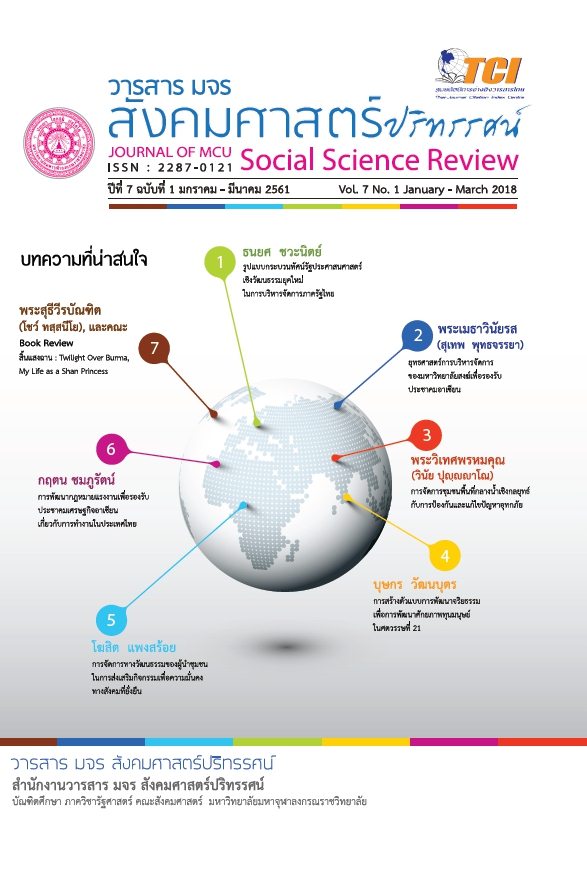การพัฒนารูปแบบการบริหารจัดการการสอนศีลธรรมของมหาวิทยาลัยสงฆ์ ในสถานศึกษาขั้นพื้นฐาน
บทคัดย่อ
บทความนี้มีวัตถุประสงค์เพื่อศึกษาสภาพการบริหารจัดการการสอนศีลธรรมของมหาวิทยาลัยสงฆ์ ในสถานศึกษาขั้นพื้นฐาน และเพื่อนำเสนอรูปแบบการบริหารจัดการการสอนศีลธรรมของมหาวิทยาลัยสงฆ์ ในสถานศึกษาขั้นพื้นฐาน ใช้วิจัยวิธีเชิงผสานวิธี เครื่องมือที่ใช้ได้แก่ แบบสอบถามผู้บริหาร เจ้าหน้าที่ และพระสอนศีลธรรม จำนวน 385 คน และแบบสัมภาษณ์ผู้ทรงคุณวุฒิ 9 คน วิเคราะห์ข้อมูลโดยใช้โปรแกรมสำเร็จรูป และใช้สถิติเชิงพรรณนา ได้แก่ ค่าร้อยละ ค่าเฉลี่ย ส่วนเบี่ยงเบนมาตรฐานและการวิเคราะห์เนื้อหา
ผลการวิจัยพบว่ 1. มหาวิทยาลัยสงฆ์ มีการบริหารจัดการการสอนศีลธรรมในสถานศึกษาขั้นพื้นฐาน ภาพรวมการบริหารจัดการทั้ง 8 ด้าน อยู่ระดับมาก โดยด้านการสื่อสารองค์กร ด้านการปฏิบัติการ ด้านการดำเนินการ ด้านการตรวจการ และด้านการทบทวน อยู่ระดับมาก ส่วนด้านการวิเคราะห์ ด้านการวางแผนและด้านการควบคุม อยู่ระดับปานกลาง ในด้านปัญหาการบริหารจัดการ พบว่า ทั้งภาพรวมและจำแนกเป็นรายด้าน อยู่ระดับปานกลาง
2.รูปแบบการบริหารจัดการการสอนศีลธรรมของมหาวิทยาลัยสงฆ์ ในสถานศึกษาขั้นพื้นฐาน ประกอบด้วย (1) แนวคิด ที่นำหลักอริยมรรคมีองค์ 8 มาเป็นแนวทางในการบริหารจัดการ เกิดเป็นระบบการบริหารแบบ 8 R Model (2) ระบบการของการบริหารจัดการตามรูปแบบ ได้แก่ การวิเคราะห์ การวางแผน การสื่อสารองค์กร การปฏิบัติการ การดำเนินการ การติดตามและตรวจสอบ การทบทวนและปรับปรุง และการควบคุมและรายงาน (3) กระบวนการบริหารจัดการตามรูปแบบ ได้แก่ สภาพแวดล้อมของงานสอนศีลธรรม ปัจจัยการบริหารจัดการ คือ งานบุคคล งบประมาณ งานวิชาการ และงานบริหารทั่วไป ขั้นตอนการดำเนินงาน เริ่มตั้งแต่การเสนอคำของบประมาณ การเตรียมความพร้อมบุคลากร การรับสมัครและพัฒนาพระสอนศีลธรรม การส่งพระสอนออกปฏิบัติงานสอน การแนะแนว ติดตาม และประเมินผล การรายงานผลกการดำเนินงาน และผลผลิต (4) ข้อดี ของรูปแบบการบริหารจัดการ คือ การสร้างองค์กรแห่งคุณธรรม มีความสอดคล้องกับองค์กรทางสังคมไม่แสวงหากำไรหรือรายได้ เสริมพลังทางการบริหารจัดการการศึกษา (5) ข้อจำกัดของรูปแบบการบริหารจัดการ คือ อาจเกิดการต่อต้านจากบุคลากรที่มีความไม่โปร่งใส ขาดความรับผิดชอบ และในระยะแรกบุคลากรอาจจะมีภาระความรับผิดขอบมากขึ้น (6) เงื่อนไขของความสำเร็จในการนำรูปแบบไปใช้ คือ จะต้องถ่ายทอดกระบวนการบริหารจัดการสู่บุคลากรทุกระดับ ประสานความร่วมมือในด้านต่าง ๆ และเร่งพัฒนาเครือข่าย
เอกสารอ้างอิง
Diamond, Catherine. (2005). Red Lotus in the Twenty-First : Cinemas in the Lao Performing Art. New theatre Quarterly.
Lo, Chi Chun Rita. (2004). Education for Personal and social Development : Case Study of a Key Secondary School in China. Dissertation Abstracts International. 64(12) : 4451-A : June.
Phillip Lewis. (1968). Instruction Process and Media Innovation. Chicago: Rand McNally.
Platz, Roland. (2003). Buddhism and Christianity in Competition? Religious and Ethnic Identity in Karen Communities of Northern Thailand.
(The Department of Cultural Science). Gallen Switzerland : St Gallen University
ดาวน์โหลด
เผยแพร่แล้ว
รูปแบบการอ้างอิง
ฉบับ
ประเภทบทความ
สัญญาอนุญาต
ลิขสิทธิ์ (c) 2019 วารสาร มจร สังคมศาสตร์ปริทรรศน์

อนุญาตภายใต้เงื่อนไข Creative Commons Attribution-NonCommercial-NoDerivatives 4.0 International License.
เพื่อให้เป็นไปตามกฎหมายลิขสิทธิ์ ผู้นิพนธ์ทุกท่านต้องลงลายมือชื่อในแบบฟอร์มใบมอบลิขสิทธิ์บทความให้แก่วารสารฯ พร้อมกับบทความต้นฉบับที่ได้แก้ไขครั้งสุดท้าย นอกจากนี้ ผู้นิพนธ์ทุกท่านต้องยืนยันว่าบทความต้นฉบับที่ส่งมาตีพิมพ์นั้น ได้ส่งมาตีพิมพ์เฉพาะในวารสาร มจร สังคมศาสตร์ปริทรรศน์ เพียงแห่งเดียวเท่านั้น หากมีการใช้ภาพหรือตารางหรือเนื้อหาอื่นๆ ของผู้นิพนธ์อื่นที่ปรากฏในสิ่งตีพิมพ์อื่นมาแล้ว ผู้นิพนธ์ต้องขออนุญาตเจ้าของลิขสิทธิ์ก่อน พร้อมทั้งแสดงหนังสือที่ได้รับการยินยอมต่อบรรณาธิการ ก่อนที่บทความจะได้รับการตีพิมพ์ หากไม่เป็นไปตามข้อกำหนดเบื้องต้น ทางวารสารจะถอดบทความของท่านออกโดยไม่มีข้อยกเว้นใดๆ ทั้งสิ้น





